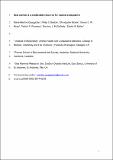Files in this item
Seal carrion is a predictable resource for coastal ecosystems
Item metadata
| dc.contributor.author | Quaggiotto, Maria-Martina | |
| dc.contributor.author | Barton, Philip S. | |
| dc.contributor.author | Morris, Christopher D. | |
| dc.contributor.author | Moss, Simon E. W. | |
| dc.contributor.author | Pomeroy, Patrick P. | |
| dc.contributor.author | McCafferty, Dominic J. | |
| dc.contributor.author | Bailey, David M. | |
| dc.date.accessioned | 2019-03-19T00:38:41Z | |
| dc.date.available | 2019-03-19T00:38:41Z | |
| dc.date.issued | 2018-04 | |
| dc.identifier.citation | Quaggiotto , M-M , Barton , P S , Morris , C D , Moss , S E W , Pomeroy , P P , McCafferty , D J & Bailey , D M 2018 , ' Seal carrion is a predictable resource for coastal ecosystems ' , Acta Oecologica , vol. 88 , pp. 41-51 . https://doi.org/10.1016/j.actao.2018.02.010 | en |
| dc.identifier.issn | 1146-609X | |
| dc.identifier.other | PURE: 252704360 | |
| dc.identifier.other | PURE UUID: 8e440eab-8885-4f03-80ef-fce767feae1a | |
| dc.identifier.other | RIS: urn:F6F6B770BDEE2FFD516B8E1D14BCEED7 | |
| dc.identifier.other | Scopus: 85044113979 | |
| dc.identifier.other | ORCID: /0000-0003-1603-5630/work/46569073 | |
| dc.identifier.other | WOS: 000432765600005 | |
| dc.identifier.uri | https://hdl.handle.net/10023/17309 | |
| dc.description | This work was supported in part by NERC National Capability funding to the Sea Mammal Research Unit (grant no. SMRU1001). MMQ was funded by a College of Medical, Veterinary and Life Sciences PhD Scholarship (University of Glasgow) to undertake this research. | en |
| dc.description.abstract | The timing, magnitude, and spatial distribution of resource inputs can have large effects on dependent organisms. Few studies have examined the predictability of such resources and no standard ecological measure of predictability exists. We examined the potential predictability of carrion resources provided by one of the UK's largest grey seal (Halichoerus grypus) colonies, on the Isle of May, Scotland. We used aerial (11 years) and ground surveys (3 years) to quantify the variability in time, space, quantity (kg), and quality (MJ) of seal carrion during the seal pupping season. We then compared the potential predictability of seal carrion to other periodic changes in food availability in nature. An average of 6893 kg of carrion ∙yr−1 corresponding to 110.5 × 103 MJ yr−1 was released for potential scavengers as placentae and dead animals. A fifth of the total biomass from dead seals was consumed by the end of the pupping season, mostly by avian scavengers. The spatial distribution of carcasses was similar across years, and 28% of the area containing >10 carcasses ha−1 was shared among all years. Relative standard errors (RSE) in space, time, quantity, and quality of carrion were all below 34%. This is similar to other allochthonous-dependent ecosystems, such as those affected by migratory salmon, and indicates high predictability of seal carrion as a resource. Our study illustrates how to quantify predictability in carrion, which is of general relevance to ecosystems that are dependent on this resource. We also highlight the importance of carrion to marine coastal ecosystems, where it sustains avian scavengers thus affecting ecosystem structure and function. | |
| dc.format.extent | 11 | |
| dc.language.iso | eng | |
| dc.relation.ispartof | Acta Oecologica | en |
| dc.rights | © 2018 Elsevier Masson SAS. This work has been made available online in accordance with the publisher’s policies. This is the author created, accepted version manuscript following peer review and may differ slightly from the final published version. The final published version of this work is available at hhttps://doi.org/10.1016/j.actao.2018.02.010 | en |
| dc.subject | Predictability | en |
| dc.subject | Resource subsidy | en |
| dc.subject | Coastal | en |
| dc.subject | Carcass | en |
| dc.subject | Pinniped | en |
| dc.subject | Relative standard error | en |
| dc.subject | Scavenger | en |
| dc.subject | QH301 Biology | en |
| dc.subject | NDAS | en |
| dc.subject | NERC | en |
| dc.subject | SDG 14 - Life Below Water | en |
| dc.subject.lcc | QH301 | en |
| dc.title | Seal carrion is a predictable resource for coastal ecosystems | en |
| dc.type | Journal article | en |
| dc.description.version | Postprint | en |
| dc.contributor.institution | University of St Andrews. School of Biology | en |
| dc.contributor.institution | University of St Andrews. Sea Mammal Research Unit | en |
| dc.contributor.institution | University of St Andrews. Marine Alliance for Science & Technology Scotland | en |
| dc.contributor.institution | University of St Andrews. Scottish Oceans Institute | en |
| dc.contributor.institution | University of St Andrews. Centre for Research into Ecological & Environmental Modelling | en |
| dc.identifier.doi | https://doi.org/10.1016/j.actao.2018.02.010 | |
| dc.description.status | Peer reviewed | en |
| dc.date.embargoedUntil | 2019-03-19 |
This item appears in the following Collection(s)
Items in the St Andrews Research Repository are protected by copyright, with all rights reserved, unless otherwise indicated.

